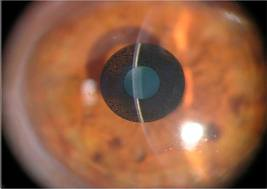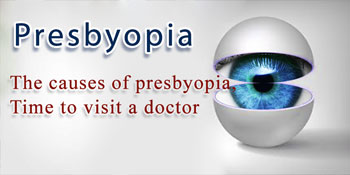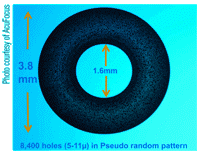Presbyopia
Before the operation, the ophthalmologist examines your eyes completely, and if necessary, subspecialty consultation is also performed for examining the retina and ocular pressure. Once examinations were completed, the lens number should be measured. Once it was determined, your lens is ordered and prepared. If necessary, other measures such as retina imaging (oct and cornea (topography and specular) are also performed and you receive a time for operation. Again sometimes, you may be required to refer to a retina subspecialist or internal or anesthetic specialist. If you have any special disease such as diabetes, hypertension, or any other diseases, you should inform the treatment team and your ophthalmologist.
According to the opinion of the ophthalmologist, from several days before the surgery, you may be prescribed eye drops to prevent inflammation or infection. In this case, you should use the drugs according to the order. If you use another drug for your disease, inform your ophthalmologist, so that they give you the necessary recommendations on continuing those drugs. Sometimes, you may be required to change your drug regimens especially your anticoagulants, antidiabetic agents, and other drugs.
It is reemphasized that if you have any special disease or use any special medication, inform your ophthalmologist.
Selection of the type of lens
Concerning selection of the type of lens, the ophthalmologist and treatment team will help you and with the propose the proper lens for you. Therefore, never be worried about it. If your eyes are suitable for toric lenses (astigmatism) or multifocal lenses, they would be suggested to you. Nevertheless, if for any reason such as limited budget, unwillingness or lack of confidence, you did not like to use these lenses and prefer to use typical lenses, there is no worry because after the operation to correct the remaining effects of the eye, you can use glasses. Multifocal lenses may not be suitable for all people and especially those who drive the night for a long time.
Preparation for the operation and day of operation
Concerning fasting, you should receive the necessary information prior to the surgery from the treatment team or your ophthalmologist. The night before the surgery or on the day of surgery before entering the clinic, you are recommended to bath and clean your face and head completely. On the day of surgery, after going to the reception, complete your file and documents and wait in the preparation sector in order to be transferred to the operation room. Most eye operations including cataract are performed without general anesthesia. However, if general anesthesia has been recommended for you, you should have not consumed any foods or liquids at least eight hours before the surgery. If your operation is performed without complete anesthesia, your eyes are absolutely anesthetized and you will be pain-free and don’t worry about that. During the operation, pay attention to the recommendations and orders of the surgeon and their assists and have the necessary cooperation.
We do our best to facilitate everything so that you have the minimum waiting. Nevertheless, sometimes unfortunately due to the long stages of preparation, patient density in the operation room, or business of the physician and some other unpredicted factors, you may have to wait more than usual. Accordingly, we apologize for that and highly appreciate your patience.
Post operation
Immediately after the operation, you will be transferred to the recovery room and then to the ward, after which you will be discharged. Before the discharge, your vital signs and general status will be controlled by the nurse of the ward. Nevertheless, if you feel any special problem, inform the nursing staff either through you or your companions.
If at the time of discharge, any drop or drug was given to you, consume them according to the order. Otherwise, the day after the operation and after the first visit by the ophthalmologist, the necessary drops or drugs will be prescribed for you. Continue the drugs according to the order and as long as no order has been given until their command for stopping.
Typically, the day after the surgery, you will be examined by your ophthalmologist or their colleague and you would receive the necessary recommendations. Your vision will improve significantly in the early days following the operation, and you will be able to use your eyes normally. In some cases, given the special situation of your eyes, on the early days, you may have blurred vision, but over time it will improve. If you experienced severe decline in vision or severe abnormal pain within several days after the operation, immediately refer to your ophthalmologist, and if they were not available or the center in which you had been operated was off, refer to one of the emergency centers for the eyes in the city.
Parsian ophthalmology specialty and subspecialty complex has the most up-to-date and complete facilities and the most well-equipped operation rooms. Further, the physicians of this clinic have great experience and skills in performing advanced cataract operations and incorporation of modern intraocular lenses.
Presbyopia
Presbyopia means gradual decline in the ability of the eyes performance to focus on close objects. This disorder is considered as part of the natural events of aging and usually begins from the age of 40.
Presbyopia manifests itself when the person wants to study something nearby, but due to blurred vision, they cannot do it. Undergoing systematic examinations of the eyes can contribute to confirmation of presbyopia.
This disorder is easily treatable using typical study glasses via contact lenses and glasses. Also, surgery can also be used as treatment.
Causes of presbyopia
In order to develop a clear image of an object on the retina, the focusing structures such as cornea and lens should perform their function properly. Unlike cornea, the lens has greater flexibility and by enhancing its thickness for seeing nearby objects, it causes greater concentration of optical beams, such that the image of the object is developed clearly on the retina. This change in thickness is performed through contraction of special intraocular muscles.
With aging, some changes occur in the eyes, which according to many ophthalmologists, the further rigidity of lens leads to presbyopia.
When the lens gradually loses its flexibility, it cannot change its thickness and therefore would not be able to concentrate the optical beams resulting from nearby objects on the retina favorably, as a result of which the resulting images will be blurry.
When should we refer to an Ophthalmologist?
If the severity of disorder is so high that the person is not able to study from near distances or do their activities as desired or the quality of images is so low that the motivation of the person for doing activities decreases, they should refer to an ophthalmologist.
Diagnosing Presbyopia
This disorder can be diagnosed through clinical examinations of the eyes and the diagnosis is usually made by a specialist. Diagnostic methods are different and are performed via special instruments, such that application of all of them is important since it affects the treatment.
Generally, if a person does not use glasses or contact lenses and has no problems of the eyes and has little chance of developing eye diseases, they should refer between 30 and 39 years of age at least twice, between 60 and 6040 years of age every two or four years, and above 65 years of age every one or two years for eye examinations.
On the other hand, if a person uses glasses or lens, the examinations should be performed within shorter intervals. However, in case of existence of any eye symptoms or problems, even in case of recent examination, re-examination should be performed by ophthalmologist. For example, blurred vision may suggest a symptom requiring the person to change their glasses or lens.
The methods for treating presbyopia include use of glasses, contact lenses, and surgical methods. If up to incidence of presbyopia, the person has had no problems, one can treat them only through study glasses, but this therapeutic method should be absolutely supervised by an ophthalmologist.
However, if the person uses glasses or contact lenses due to astigmatism, nearsightedness, or farsightedness, study glasses alone are not sufficient and special glasses should be used which include bifocal or gradual glasses as well as bifocal or multifocal contact lenses.
There are also some surgical methods which are numerous, but none of them are used as a verified treatment as a method.
Personal care
Although presbyopia is not preventable, by taking special measures one can protect the eyes and vision. They include:
– undergoing regular and proper eye examinations by ophthalmologist
controlling underlying diseases such as diabetes and hypertension which adversely affect the vision
rapid and timely referral to physician in case of incidence of symptoms such as sudden decline in vision
blurred vision, optical sparks, dark spots in the field of vision, and any other symptoms.
Treatment of Presbyopia
The simplest way for treating presbyopia is use of glasses. However, there are different surgical methods for those who cannot or do not like using glasses.
KAMRA Inlay
Inlay refers to any instrument Inc. inside the corneal tissue. One of these instruments is commercially called KAMRA made by Acufocus company, USA.
This instrument is made of a small round plane similar to human pupil with a very advanced technology. Its diameter is 3 mm and its thickness is only 5 micron, in the middle of which a hole around 1.7 micron has been devised. It has thousands of tiny holes for oxygen exchange. This instrument is incorporated inside the cornea using Femtosecond laser device, which can be used by the patient for both far and near visions. This operation is outpatient and is usually performed on only one eye.
Persian Eye Clinic is among the first centers of the country providing this advanced technology for patients.
Currently, in order to investigate the long-term results in patients undergoing this instrument, we have stopped this operation until a further notice.

Mono Vision
In this method using the laser, one eye is corrected for the far sight and the other is corrected for the near sight. When the patient sees by both of their eyes, they can see both the near and far. However, if they close the eye corrected for the far sight, they will see the far as blurry. In this method, it takes time for the patient to get used to their new vision status.
Phemtolasic and Presby-LASIK
For presbyopia, usage of Eximer laser with femtopasik technology is also possible. Although this operation has a long background, recently some manufacturing companies have presented novel methods for this purpose. We also enjoy two advanced technologies including PresbyMAx and SupraCor for this purpose. It can be performed in patients who are at the age of presbyopia and suffer both nearsightedness and farsightedness concurrently. Using Eximer laser and femtolasic technique, the cornea becomes multifocal and the person would be able to see both near and far sights.
Although in Persian Eye Clinic, we have performed this technique successfully on a limited number of patients, for the time being we do not perform this technique routinely until reaching long-term outcomes and with a large number of patients.


